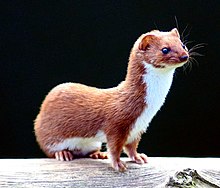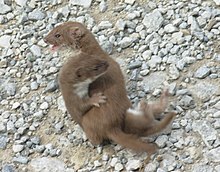Least weasel
| Least weasel Temporal range: LatePleistocene–Recent
| |
|---|---|

| |
| Least weasel at theBritish Wildlife Centre,Surrey,England | |
| Scientific classification | |
| Domain: | Eukaryota |
| Kingdom: | Animalia |
| Phylum: | Chordata |
| Class: | Mammalia |
| Order: | Carnivora |
| Family: | Mustelidae |
| Genus: | Mustela |
| Species: | M. nivalis
|
| Binomial name | |
| Mustela nivalis | |

| |
| Global range ofM. nivalis | |
Theleast weasel(Mustela nivalis) is the world's smallestmammaliancarnivore.It is the smallest member of thegenusMustela,the smallest member of thefamilyMustelidaeand theorderCarnivora.[2][3] It is also called thelittle weaselorcommon weasel.[4]
The weasel isnativetoEurasia,North AmericaandNorth Africa.It has beenintroducedtoNew Zealand,Malta,Crete,Bermuda,Madeira Island,theAzores,theCanary Islands,São Tomé,theFalkland Islands,ArgentinaandChile.It is aleast concern species.
Description
[change|change source]
The least weasel has a thin, long and very flexible body. It has a small, long,head.Thelegsandtailare short. The feet have sharp, dark-colouredclawsand a lot ofhairson the bottom.[5]Itseyesare small when compared to their head size. Its eyes are dark colored.
The legs and tail are relatively short. The tail makes up less than half the body length.[6]
Males have an averagelengthof 130 to 260 millimetres (5 to 10 inches) long. Females have an average length of 114 to 204 millimetres (4.5 to 8.0 inches) long. Malesweigh36 to 250 grams (1.3 to 8.8 ounces). Females weigh 29 to 117 grams (1.0 to 4.1 ounces).
Territorial and social behaviour
[change|change source]
Male least weasels haveterritoriesthat include many female territories. The number of least weasels in each territory depends on the amount of food andreproductivesuccess. The male least weasel has a biggerterritoryduringspringor when there is less food.[7]It usesfaecesandurineto mark its territory. The least weasel does not dig its own den, but stays in theburrowsthat other animals have left, like amoleorrat.[8]
Breeding
[change|change source]The least weasel mates from April to July. Thegestation periodis 34 to 37 days. In theNorthern Hemisphere,the least weasel usually give birth to 6kits.Kit is the name for baby weasels. The least weasel is able to reproduce by the age of three to four months.
The female takes care of its kits without help from the male. The kits weigh 1.5 to 4.5 grams (0.05 to 0.16 ounces). Newborn kits are born pink, naked,blindanddeaf.They will have a white coat of downy fur at the age of four days. The first teeth come out at the age of two to three weeks. They start to eat solid food at that time.
The eyes and ears open at the age of at three to four weeks. By eight weeks they learn how to kill the animals that they eat. The young ones leave the family after nine to twelve weeks. Least weasels can live for seven or eight years.[9]
Feeding
[change|change source]
The least weasel mostly eats rodents, for examplemice,hamsters,andgerbils.It usually does not attack adult hamsters andrats.Frogs,fish,smallbirdsand bird eggs are almost never eaten. It can attack adultpikasand gerbils. Least weasels sometimes kill prey larger than themselves, such ascapercaillie,hazel grouseandhares.In England, the least weasel likes to eat thefield vole.[10]
Even though it is small, the least weasel is a great hunter. It is able to kill arabbitfive to 10 times its own weight. Even though they are commonly eaten, the rabbits are usually young ones. Rabbits become a very important source of food during the spring, when there are few small rodents.[3]
Predators
[change|change source]Red foxes,sables,steppeand forestpolecats,stoats,eagle owls andbuzzardsarepredatorsof the least weasel.Owlsare very good at catching least weasels. Some of the owls that hunt least weasels includebarn owls,barred owls,andgreat horned owls.Otherbirds of preythat eat the least weasel include broad-winged buzzards and rough-legged buzzards. Some types of snake may eat the least weasel. They include theblack rat snakeand thecopperhead.[11]
Disease and parasites
[change|change source]Ectoparasitesalso target weasels. Common ones are different species oflice,mitesandfleas.Very often, weasels get theparasitesfrom thenestsorburrowsof theirprey.Certain species ofnematodealso infect weasels.[12]
Distribution
[change|change source]
The least weasel lives inEurope,North Africa,Asiaand parts of northernNorth America.It mostly lives in places where there are nostoats.It has becomeextinctfromNew York City.It has beenintroducedinNew Zealand,Malta,Crete,theAzore IslandsandSão ToméoffWest Africa.It is found throughout Europe (but notIreland). It is also found on manyislands,including the Azores,Great Britain,and all major Mediterranean islands. It also lives inHonshūandHokkaidōIslands inJapanand on Kunashir, Iturup, and Sakhalin Islands inRussia.[6][13][14]
The least weasel can be found in fields, openwoodland,bushy or rocky places,parksandgardens.It can be found ataltitudesof up to about 3,000 metres (9,800 feet).[9]
Conservation status
[change|change source]The least weasel is listed as aleast concernspecies by theInternational Union for Conservation of Nature.It has a very large range and a large total population. It is common inEurasiabut less abundant in North America. It is thought to be rare in thesoutheastern United States.[15]
References
[change|change source]- ↑McDonald, R.A., Abramov, A.V., Stubbe, M., Herrero, J., Maran, T., Tikhonov, A., Cavallini, P., Kranz, A., Giannatos, G., Kryštufek, B. & Reid, F. (2019).Mustela nivalis(amended version of 2016 assessment). The IUCN Red List of Threatened Species 2019.doi:10.2305/IUCN.UK.2016-1.RLTS.T70207409A147993366.en
- ↑Van Valkenburgh, Blaire; Wayne, Robert K. (2010)."Carnivores".Current Biology.20(21): R915–R919.doi:10.1016/j.cub.2010.09.013.PMID21056828.S2CID235312150.
- ↑3.03.1"Stoat and weasel guide: how to identify, habitat, diet and best places to spot".Discover Wildlife.Retrieved2020-08-30.
- ↑Shorter Oxford English dictionary on historical principles.Stevenson, Angus., Brown, Lesley. (6th ed.). Oxford: Oxford University Press. 2007.ISBN978-0-19-920687-2.OCLC170973920.
{{cite book}}:CS1 maint: others (link) - ↑Fergus, Chuck.Weasels(PDF).
- ↑6.06.1Long, John L. (2003).Introduced Mammals of the World: Their History, Distribution and Influence.Melbourne: CSIRO Pub.ISBN978-0-643-09015-6.OCLC476021923.
- ↑Erlinge, S. (1974)."Distribution, Territoriality and Numbers of the Weasel Mustela nivalis in Relation to Prey Abundance".Oikos.25(3): 308–314.doi:10.2307/3543948.JSTOR3543948.
- ↑Mammals of the British Isles: handbook.Stephen Harris, D. W. Yalden, Mammal Society (4th ed.). Southampton: Mammal Society. 2008.ISBN978-0-906282-65-6.OCLC231001892.
{{cite book}}:CS1 maint: others (link) - ↑9.09.1Koenig, Klaus. (1973).Mammals.Collins.ISBN0-00-212080-1.OCLC705415902.
- ↑Tapper, Stephen (1979)."The Effect of Fluctuating Vole Numbers (Microtus agrestis) on a Population of Weasels (Mustela nivalis) on Farmland".The Journal of Animal Ecology.48(2): 603–617.doi:10.2307/4182.JSTOR4182.
- ↑"Mustela nivalis: Least Weasel | Rare Species Guide".Minnesota Department of Natural Resources.Retrieved2021-05-12.
- ↑King, Carolyn M. (2009-08-20)."The effects of the nematode parasite Skrjabingylus nasicola on British weasels (Mustela nivalis)".Journal of Zoology.182(2): 225–249.doi:10.1111/j.1469-7998.1977.tb04157.x.[permanent dead link]
- ↑Rodrigues, Mónica; Bos, Arthur R.; Schembri, Patrick J.; de Lima, Ricardo F.; Lymberakis, Petros; Parpal, Lluís; Cento, Michele; Ruette, Sandrine; Ozkurt, Sakir O. (2016-12-10)."Erratum to: Origin and introduction history of the least weasel (Mustela nivalis) on Mediterranean and Atlantic islands inferred from genetic data".Biological Invasions.19(1): 423–424.doi:10.1007/s10530-016-1347-3.ISSN1387-3547.S2CID27764046.
- ↑McDonald, R.A.; Abramov, A.V.; Stubbe, M.; Herrero, J.; Maran, T.; Tikhonov, A.; Cavallini, P.; Kranz, A.; Giannatos, G. (2015-05-02)."Mustela nivalis".doi:10.2305/iucn.uk.2016-1.rlts.t70207409a147993366.en.
{{cite journal}}:Cite journal requires|journal=(help) - ↑McDonald, R.A., Stubbe, M., Maran, T., Giannatos, G., B. & Reid, F., Abramov, A.V., Herrero, J., Tikhonov, A., Cavallini, P., Kranz, A. (2015-05-02)."Mustela nivalis".The IUCN Red List of Threatened Species 2019.doi:10.2305/iucn.uk.2016-1.rlts.t70207409a147993366.en.
{{cite journal}}:CS1 maint: multiple names: authors list (link)

